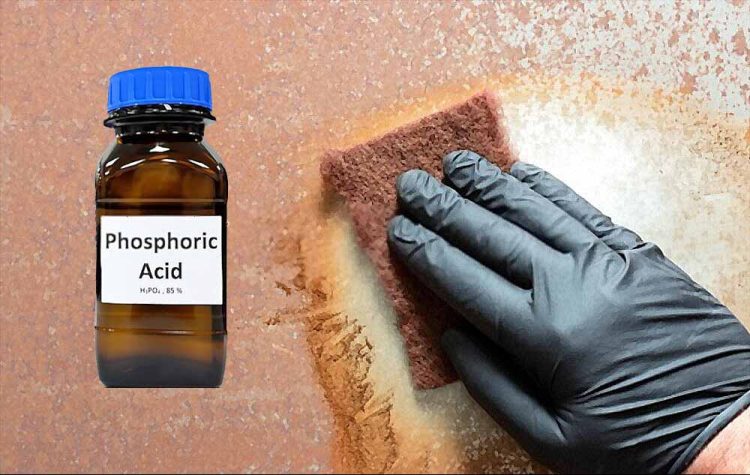Rust is a common problem for metal surfaces, causing unsightly discolouration and even structural damage if left untreated. While there are many solutions for removing rust, one that has proven to be effective is the use of phosphoric acid. Phosphoric acid is a safe and non-toxic chemical that can effectively dissolve rust from metal surfaces, making it an ideal choice for a variety of applications.
In this article, we will discuss the benefits of using phosphoric acid for rust removal and provide a step-by-step guide on how to effectively use it. Whether you’re looking to remove rust from a car, tools, or household items, this article will help you get the job done quickly and effectively.
What is Phosphoric Acid & Its Uses in Rust Removal
Phosphoric acid is a clear, colourless, and highly acidic inorganic compound with the chemical formula H3PO4. It is commonly used in the food industry as a flavouring agent and a gentle acidulant, but it also has other industrial uses, including rust removal.
Phosphoric acid works by reacting with and dissolving iron oxide, the main component of rust. When applied to a rusty surface, the acid reacts with the rust and converts it into a soluble compound that can be easily washed away.
This makes phosphoric acid a popular choice for removing rust from metal surfaces, such as cars, tools, and household items. In addition to its effectiveness, it is also non-toxic and safe for the environment, making it a versatile and safe solution for rust removal.
Benefits of Using Phosphoric Acid for Rust Removal
Here are some of the benefits of using phosphoric acid for rust removal:
- Effective on light to moderate rust: Phosphoric acid is highly effective in removing light to moderate rust, making it an ideal choice for a variety of applications.
- Non-toxic and safe for the environment: Unlike some other rust removal solutions, phosphoric acid is non-toxic and safe for the environment, making it a safe choice for use around children and pets.
- Can also be used as a rust inhibitor: In addition to removing rust, phosphoric acid can also be used as a rust inhibitor, helping to prevent rust from re-forming on metal surfaces.
- Versatile: Phosphoric acid can be used on a variety of metal surfaces, including iron, steel, and aluminium, making it a versatile solution for rust removal.
- Cost-effective: Compared to other rust removal solutions, phosphoric acid is relatively inexpensive, making it a cost-effective option for those looking to remove rust from metal surfaces.
- Easy to use: Phosphoric acid is easy to use and requires no special tools or skills, making it a convenient choice for those looking to remove rust from metal surfaces.
How to Use Phosphoric Acid for Rust Removal
In this article, we will discuss how to use phosphoric acid for rust removal.
Materials Needed:
- Phosphoric acid
- Gloves
- Protective eyewear
- Brush or cloth for application
Preparation:
- Make sure the surface is free of dirt, oil, or other debris that could interfere with the effectiveness of the phosphoric acid. You can also remove a lot of rust from the surface by using a wire wheel.
- Protect surrounding areas from the acid. Use tape, plastic, or other materials to protect nearby surfaces from any drips or splashes.
Application:
- Dilute the acid according to the instructions. The strength of the solution will depend on the type and amount of rust you need to remove. Follow the instructions carefully to ensure the best results.
- Apply to the rusty surface using a brush or cloth. Make sure to cover the entire surface of the rust.
- Let it sit for the recommended time. The length of time the solution needs to sit will depend on the type and amount of rust you need to remove.
- Rinse thoroughly with water. Use a hose, bucket, or other means to thoroughly rinse the surface of the rust.
Precautions When Using Phosphoric Acid:
- Avoid skin and eye contact. Phosphoric acid is highly acidic and can cause skin irritation and damage to the eyes. Wear gloves and protective eyewear to avoid any contact.
- Wear protective gear. In addition to gloves and protective eyewear, wear clothing that covers your arms and legs to minimize the risk of exposure.
- Store in a safe place, away from children and pets. Phosphoric acid should be stored in a cool, dry place, away from children and pets.
- Do not mix with other chemicals. Phosphoric acid should not be mixed with other chemicals, as this could cause a dangerous reaction.
Conclusion
In conclusion, phosphoric acid is a safe and effective solution for removing rust from metal surfaces. When used properly, it can quickly and easily dissolve rust, leaving the surface clean and free of discolouration. Whether you’re looking to remove rust from a car, tools, or household items, phosphoric acid is a versatile and cost-effective solution that can get the job done. Just remember to take the necessary precautions to ensure your safety while using this product.

Meet Max, the founder and lead writer of our home improvement blog. He is a seasoned home renovation and design expert with over 8 years of experience in the industry.
Max has a passion for creating beautiful and functional living spaces and is dedicated to helping homeowners and DIY enthusiasts achieve their home improvement goals. He has worked on a wide range of projects, from small updates to full-scale renovations, and has a wealth of knowledge and experience to share.
As an avid DIYer, Max understands the challenges and rewards of tackling a home improvement project and enjoys sharing his tips, tricks and insights to make the process as easy and enjoyable as possible. In his free time, Max can be found working on his own home renovation projects, reading design blogs and magazines, and travelling to explore new design trends.
Max is excited to share his knowledge and experience with you and hopes to inspire and empower you to take on your next home improvement project with confidence. Follow Max on LinkedIn for more inspiration and expert advice.


